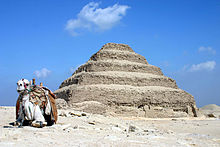
Back Saqqara Afrikaans سقارة Arabic سقاره ARZ Sakkara Azerbaijani Сакара Byelorussian Saqqara BS Saqqara Catalan Şaqqārah CEB Sakkára Czech Sakkara Danish
سقارة | |
 The stepped Pyramid of Djoser at Saqqara | |
| Location | Giza Governorate, Egypt |
|---|---|
| Region | Lower Egypt |
| Coordinates | 29°52′16″N 31°12′59″E / 29.87111°N 31.21639°E |
| Type | Necropolis |
| History | |
| Periods | Early Dynastic Period to Middle Ages |
| Site notes | |
| Part of | "Pyramid fields from Giza to Dahshur"; part of Memphis and its Necropolis – the Pyramid Fields from Giza to Dahshur |
| Includes | |
| Criteria | Cultural: (i), (iii), (vi) |
| Reference | 86-002 |
| Inscription | 1979 (3rd Session) |
| Area | 16,203.36 ha (62.5615 sq mi) |
Saqqara (Arabic: سقارة, Egyptian Arabic pronunciation: [sɑʔːɑːɾɑ]), also spelled Sakkara or Saccara in English /səˈkɑːrə/, is an Egyptian village in the markaz (county) of Badrashin in the Giza Governorate,[1] that contains ancient burial grounds of Egyptian royalty, serving as the necropolis for the ancient Egyptian capital, Memphis.[2] Saqqara contains numerous pyramids, including the Pyramid of Djoser, sometimes referred to as the Step Tomb, and a number of mastaba tombs. Located some 30 km (19 mi) south of modern-day Cairo, Saqqara covers an area of around 7 by 1.5 km (4.3 by 0.9 mi).
Saqqara contains the oldest complete stone building complex known in history, the Pyramid of Djoser, built during the Third Dynasty. Another sixteen Egyptian kings built pyramids at Saqqara, which are now in various states of preservation. High officials added private funeral monuments to this necropolis during the entire Pharaonic period. It remained an important complex for non-royal burials and cult ceremonies for more than 3000 years, well into Ptolemaic and Roman times.
North of the Saqqara site lies the Abusir pyramid complex, and to its south lies the Dahshur pyramid complex, which together with the Giza Pyramid complex to the far north comprise the Pyramid Fields of Memphis, or the Memphite Necropolis, which was designated as a World Heritage Site by UNESCO in 1979.[3]
Some scholars believe that the name Saqqara is not derived from the ancient Egyptian funerary deity, Sokar, but from a local Berber tribe called the Beni Saqqar, despite the fact that a tribe of this name is not documented anywhere.[4][5] Medieval authors also refer to the village as Ard as-Sadr (Arabic: ارض السدر, lit. 'land of the buckthorn').[6]

- ^ "Markaz al-Badrashin Map". www.giza.gov.eg. Retrieved 2023-01-22.
- ^ Fernandez, I., J. Becker, S. Gillies (19 August 2020). "Places: 796289136 (Saqqarah)". Pleiades. Retrieved March 22, 2013.
{{cite web}}: CS1 maint: multiple names: authors list (link) - ^ "Memphis and its Necropolis – the Pyramid Fields from Giza to Dahshur". UNESCO World Heritage Convention. Retrieved 2023-05-03.
- ^ Graindorge, Catherine, "Sokar". In Redford, Donald B., (ed) The Oxford Encyclopedia of Ancient Egypt, vol. III, pp. 305–307.
- ^ Peust, Carsten (2010). "Die Toponyme vorarabischen Ursprungs im modernen Ägypten: ein Katalog" (PDF). Göttinger Miszellen: Beihefte (8). ISSN 1867-9455. Archived (PDF) from the original on 2021-02-14.
- ^ Stefan, Timm (1988). Das christlich-koptische Agypten in arabischer Zeit. p. 2296.
© MMXXIII Rich X Search. We shall prevail. All rights reserved. Rich X Search
